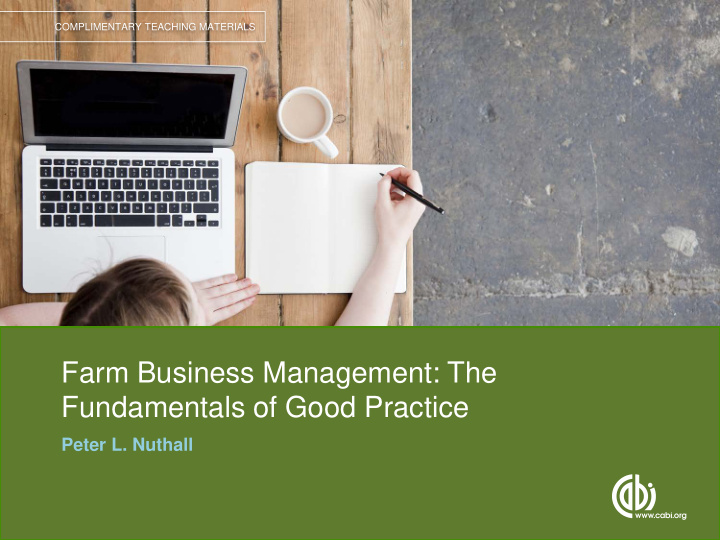



COMPLIMENTARY TEACHING MATERIALS Farm Business Management: The Fundamentals of Good Practice Peter L. Nuthall
Chapter 13 Decision and Management Processes and their Improvement COMPLIMENTARY TEACHING MATERIALS
LEARNING OBJECTIVES Become familiar with a sample of decision processes generally used by farmers. Learn a little about farmers’ technology adoption decision processes. Reinforce ideas about assessing a farmer’s objectives, and the form they take. Discover the concept of decision bias, and the forms farmers’ biases might take. Become aware that stress can be a factor in a farmer’s life and this may impact on management efficiency. Consider possible avenues in tackling stress problems. Learn about the general methods of improving a farmer’s managerial ability. COMPLIMENTARY TEACHING MATERIALS
Decision Processes: The Basics Every farmer develops his own system. React to stimuli (both on and off farm) (e.g. prices rise) leads to consideration, analysis, solution and action if appropriate. Range of potential process methods. Extremes are: • follow colleague leaders where their actions are observable; • linear approach: information gathering through to action in linear steps; dynamic approach: backwards and forwards through steps with • constant review. Simplify complex situations by ‘chunking’, i.e. breaking problem into sections. Benchmarking used to decide whether problem exists and whether action is required. COMPLIMENTARY TEACHING MATERIALS
Decision Processes: Subsequent Factors Simplifying processes: • reduce options considered through initial quick assessment; • seek an acceptable, in contrast to an optimal, solution; • use constructs (rules of thumb learnt from experience). Adoption of new systems and technology: • farmers assess whether to take up or not. • Assessment depends on ease of trialability, complexity, comparability, observability. • Impacted by the belief of others’ views, what resources available allow, and farmer’s own beliefs (theory of planned behaviour). Objectives guide the process: whether they involve maximization; satisficing; and attitude to risk. COMPLIMENTARY TEACHING MATERIALS
Biases: The Basics Biases detract from success, leading to sub-optimal decisions: eradicate when possible. Need to recognize the important biases: examples include poor knowledge, poor processes, personality quirks. General categories of bias: poor/incorrect information on all relevant relationships and situations, markets, understanding biology (soils, plants, animals), production economics, analytical methods. COMPLIMENTARY TEACHING MATERIALS
Specific Types of Known Biases Observational biases: learning approach, halo effect, anchoring, selective abstraction, sample size, flawed procedures. Forecasting biases: dichotomous thinking, probability failures, technical errors, lazy bias, recency effect. Decision process biases: incorrect risk analysis, using averages instead of marginality, ignoring time impacts, and many others. Implementation biases: incorrect chunking, poor prioritization, timing errors, lack of review and control. Personal relationship biases: low self-esteem, over confidence, non- communicative. General biases: uncritical of computer solutions, aversion to change. COMPLIMENTARY TEACHING MATERIALS
Stress Stress disrupts the decision process as well as general enjoyment. Stress stems from personality, upbringing, debt level, personal relationships and health. Triggers many and varied: relate to current mental situation; weather; market drops; animal and plant disease outbreaks; overpowering regulations (environmental?); isolation, etc. Combating stress: ask (determine) what was the primary source of stress? Two basic approaches: modifying the situation (e.g. get irrigation) and modifying the mental approach. Mental approaches: blocking, sharing, displacement (modify expectation as unrealistic), positivism, relaxation, avoidance. COMPLIMENTARY TEACHING MATERIALS
Methods of Improving Managerial Ability: The Basics Extent of improvement possible varies with the farmer, e.g. depending on their current level, ability to change. To assess: 1. grade farmer on all the skills covered in previous chapters; 2. review and decide on biases; 3. decide appropriate learning style for the farmer. Learning processes: • farmer must be willing and accept change is possible; • farmer must accept that specific defined areas need improvement; • repetition and reinforcement important for change; • feedback essential; • self-critiquing essential and must be developed; • ensure constant review of decisions made and the outcomes that result. COMPLIMENTARY TEACHING MATERIALS
Methods of Improving Managerial Ability: Change Methods Self-help: Homework to sort out procedures. Simulation: Simulating situations and practising resolution (mental $/or computer-based games and scenarios). Mentoring: One-to-one using professional or similar, or in colleague groups of smaller size. Approach: Non-judgemental; open and frank; trust, sympathy, understanding; role playing; de-sensitization; use of professional guidance (consultant?). Role models: Observe and discuss. Outcomes: Important formal processes improved; intuition improved and strengthened (e.g. tacit knowledge, constructs). Note the vast majority of decisions are made using intuition. COMPLIMENTARY TEACHING MATERIALS
Thank You Name: First Surname Email: email@email.com COMPLIMENTARY TEACHING MATERIALS
Recommend
More recommend